The Cost of Building the Cleanest Village: Give Me Water and Power, and I Will Give You a Cleaner and Greener Tripura
Dr. Dustin Lalkulhpuia
May 31, 2024, 11:29:54

Deep
in the remote Jampui Hills of Tripura, nestled at an altitude of 800 meters, lay
the villages of Vanghmun and Behliangchhip. These are no ordinary settlements –
they are beacons of cleanliness, shining examples of what can be achieved when
a community comes together, driven by a shared sense of purpose and a
deep-rooted commitment to environmental stewardship.
While
the Indian government's Swachh Bharat campaign has been a catalyst for
change across the nation, these villages have taken the initiative to a whole
new level, largely through the efforts of local NGOs, churches, and the
unwavering spirit of cooperation that permeates every aspect of village life.
At
the heart of this remarkable story lies the hive hypothesis, a theory posited
by moral psychologist Jonathan Haidt that suggests human beings have evolved to
be "super cooperators," thriving in groups that transcend individual
self-interest for the greater good. The story of these two villages is not
merely a matter of aesthetics or civic pride; it is a manifestation of a deeper
truth – that human beings are, at their core, cooperative creatures, capable of
transcending individual limitations to create a better world for all.
As
one walks through the pristine streets of Vanghmun and Behliangchhip, it
becomes clear that these villages are more than just physical spaces — they are
living embodiments of the hive hypothesis, demonstrating the incredible
potential of human cooperation and collective action. Here, the lines between
individual and community interests have blurred, replaced by a shared mission
to create a cleaner, healthier, and more sustainable environment for all. The
efforts of the YMA, the churches, and the villagers themselves exemplify the
power of cooperation, transcending the limitations of individual self-interest
and showing what can be achieved when people unite for a common purpose.
The
Driving Force: NGOs and Churches
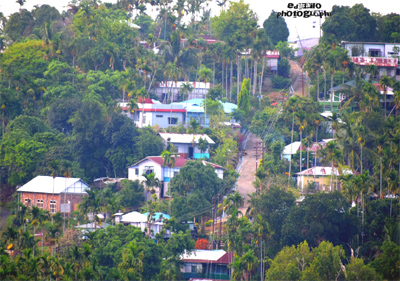 In
Vanghmun and Behliangchhip, the mantle of environmental stewardship has been
taken up not solely by the government, but by a coalition of dedicated NGOs and
churches. Chief among these is the Young Mizo Association (YMA), a voluntary
organization that has been at the forefront of promoting cleanliness and
environmental protection through its annual campaigns.
In
Vanghmun and Behliangchhip, the mantle of environmental stewardship has been
taken up not solely by the government, but by a coalition of dedicated NGOs and
churches. Chief among these is the Young Mizo Association (YMA), a voluntary
organization that has been at the forefront of promoting cleanliness and
environmental protection through its annual campaigns.
The
YMA and the Church's efforts extend far beyond mere awareness-raising. They
have taken a hands-on approach, mobilizing the entire community – from the
elders to the youth – in a collective effort to keep their villages pristine.
Guided by the principles of cooperation and shared responsibility, the YMA has
instilled a deep sense of ownership and pride among the villagers, transforming
cleanliness into a way of life.
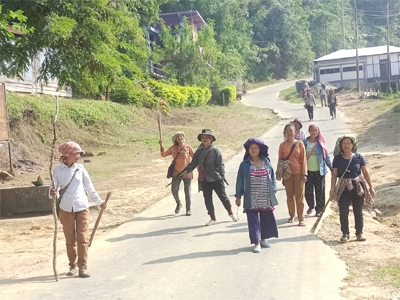 The
Church’s impact goes even deeper. Recognizing the importance of shaping young
minds, the organization has taken an innovative approach by incorporating
environmental education into the ‘Sunday School’ curriculum. Here, the
teachings of Christ are seamlessly interwoven with lessons on the importance of
cleanliness and environmental protection, fostering a generation of responsible
stewards from a tender age.
The
Church’s impact goes even deeper. Recognizing the importance of shaping young
minds, the organization has taken an innovative approach by incorporating
environmental education into the ‘Sunday School’ curriculum. Here, the
teachings of Christ are seamlessly interwoven with lessons on the importance of
cleanliness and environmental protection, fostering a generation of responsible
stewards from a tender age.
In
these predominantly Christian villages, the church has played a pivotal role in
reinforcing the message of cleanliness and environmental stewardship. By
contextualizing these values within the framework of their faith, the church
has created a powerful resonance that extends far beyond mere compliance with
civic regulations. Sermons and teachings emphasize the importance of respecting
God's creation, drawing parallels between spiritual purity and the cleanliness
of one's surroundings. The younger members of the church, known as the Baptist
Naupang Pawl, Salvation Army YP, etc. are guided by their elders, learning
that their actions have a direct impact on the well-being of their community
and the preservation of the natural world around them.
This
holistic approach has borne fruit, as the villagers proudly proclaim sayings
like, “How you dispose of your garbage reflects who you are.” Cleanliness has
become a mark of civilized behavior, and littering or improper waste disposal
is viewed as not just an environmental offense, but a violation of the values
that bind the community together.
It
Cost Too Much to be Clean
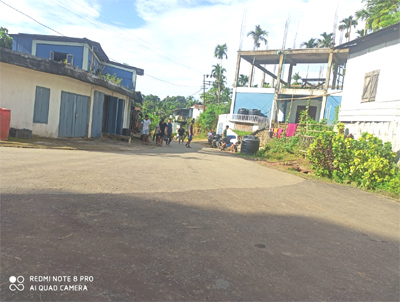 Despite
their unwavering commitment to cleanliness, the villages of Vanghmun and
Behliangchhip face significant challenges, chief among them being water
scarcity. While the average urban Indian consumes around 135 liters of water
per day, and rural areas average around 71 liters, the residents of these
hilltop villages make do with a mere 20-25 liters per person daily.
Despite
their unwavering commitment to cleanliness, the villages of Vanghmun and
Behliangchhip face significant challenges, chief among them being water
scarcity. While the average urban Indian consumes around 135 liters of water
per day, and rural areas average around 71 liters, the residents of these
hilltop villages make do with a mere 20-25 liters per person daily.
The
government's efforts to address this issue have been hampered by poor water
sources, low-quality technology, and intermittent electricity supply. Yet, remarkably,
the villagers have found a way to maintain their high standards of cleanliness,
even in the face of such adversity.
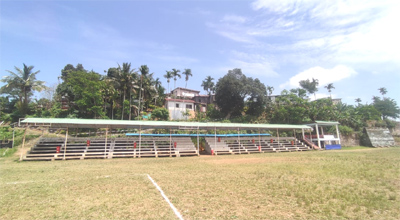 Rainwater
harvesting has emerged as a viable solution, with villagers collecting and
storing every precious drop to meet their daily needs. However, this practice
alone is not enough to sustain their efforts, and the people of Vanghmun and
Behliangchhip have had to make significant personal
sacrifices, investing in water storage tanks, inverters, and generators to
ensure a consistent supply.
Rainwater
harvesting has emerged as a viable solution, with villagers collecting and
storing every precious drop to meet their daily needs. However, this practice
alone is not enough to sustain their efforts, and the people of Vanghmun and
Behliangchhip have had to make significant personal
sacrifices, investing in water storage tanks, inverters, and generators to
ensure a consistent supply.
Waste
management is another area where the villages have taken matters into their own
hands. In Behliangchhip, the YMA and Village Council have raised funds to
establish a dedicated dumping site, although
these locally established sites are not scientifically designed, the locals
have done their best with the resources at hand. Every
household contributes to this effort, either disposing of their waste directly
or hiring someone to transport it to the designated site.
In
Vanghmun, a similar system is in place, with the YMA collecting donations from
villagers to hire vehicles that collect and transport waste on a weekly basis.
This initiative not only keeps the village clean but also generates employment
opportunities for local youth. "This is being done solely out of voluntary effort."
Give
Me Water and Power, and I will give you a Cleaner and Greener Tripura:
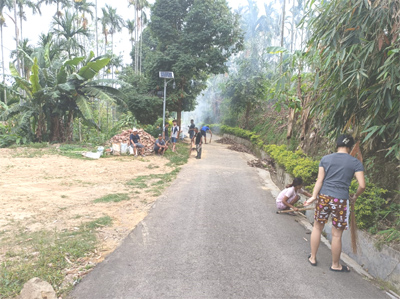 The
efforts of the villagers and their NGO partners have been remarkable, yet
greater government support is essential for the long-term sustainability of
these initiatives. By addressing the water crisis and providing reliable, clean
water sources, the government can significantly reduce the villagers' burden
and allow resources to be directed towards other aspects of environmental
preservation. If the government can solve the water crisis in this area, the
people can, in turn, maintain a cleaner environment for the government.
The
efforts of the villagers and their NGO partners have been remarkable, yet
greater government support is essential for the long-term sustainability of
these initiatives. By addressing the water crisis and providing reliable, clean
water sources, the government can significantly reduce the villagers' burden
and allow resources to be directed towards other aspects of environmental
preservation. If the government can solve the water crisis in this area, the
people can, in turn, maintain a cleaner environment for the government.
Additionally, the government can
streamline waste management by employing and paying individuals to collect and
transport waste regularly. This would create a more efficient system and remove
the financial burden on villagers who currently contribute to this cause.
Providing adequate dustbins, particularly
in market areas, and distributing segregation bags to each household would
enhance the waste management process, ensuring proper sorting and
environmentally responsible disposal.
It is crucial to note that, despite the
excellent cooperation among the villagers, the cost of maintaining cleanliness
in Jampui Hill is very high. Proper electric and water supplies could greatly
alleviate this issue. Villagers currently spend significant amounts of their
own money on water, inverters, generators, and other necessities to achieve
their cleanliness goals.
The
efforts of the NGOs and Churches in this cleanest village (GP) of Tripura are
truly commendable, but they cannot sustain these initiatives alone. It is
imperative that the government extends its support by providing the necessary
resources, infrastructure, and personnel to ensure that these villages remain
beacons of cleanliness and environmental sustainability.
(Tripurainfo)